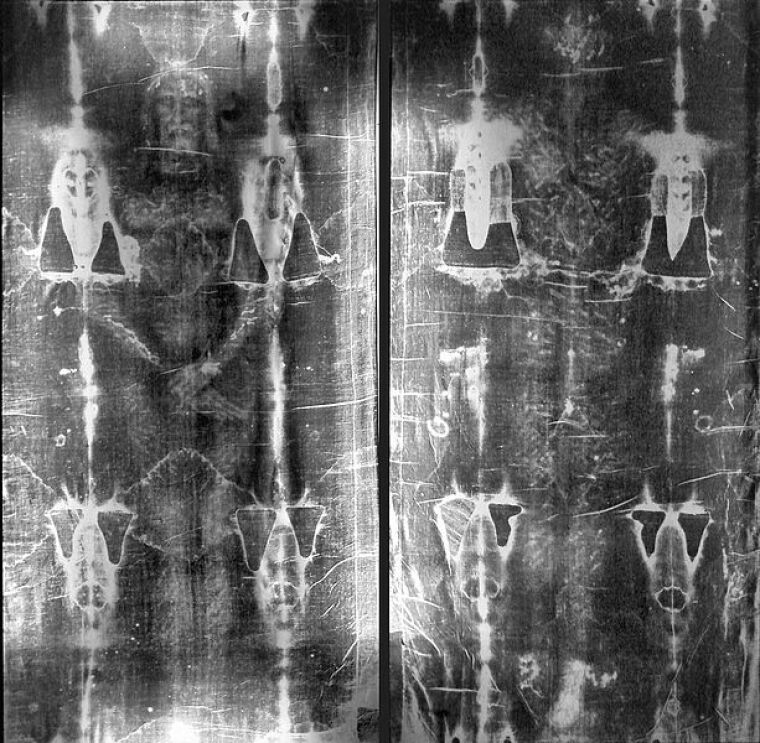Shroud of Turin contains marks consistent with Christ's spear wound, says study

A new study has indicated that the Shroud of Turin, which is believed to be the burial shroud of Christ, has marks of a spear wound that is consistent with the one inflicted on Jesus when he was hung on the cross.
The study was released by researchers from the Catholic University of Murcia (UCAM) in Spain last week, Church Militant reported.
The report details the tissues and organs that would have been pierced by the spear in its "hypothetical trajectory," and it notes that whoever inflicted the wound had experience with a weapon, based on the fact that the object went deftly between the victim's ribs at precisely the right spot in the first instance.
The researchers also presented the latest forensic evidence that suggests that the Shroud of Turin and the Shroud of Oviedo were from the same period and that they covered the same person.
The Shroud of Oviedo, which has been housed in the cathedral town of Oviedo in northern Spain since the 11th century, is believed to be the cloth that was wrapped around the head of Christ. Although not as famous as the Shroud of Turin, it has attracted similar devotion, which prompted some discussions about its authenticity.
Alfonso Sánchez-Hermosilla, one of the lead researchers, said that the report "not only reaffirms that both garments involved the same person, but also that, when already a corpse and standing upright, the person suffered a penetrating wound."
Sánchez-Hermosilla said that the bloodstains they examined on the Shroud of Oviedo have not been previously studied, adding that they had been attributed to marks caused by flogging wounds.
The researchers also found that not all of the stains were from a living person. Some of it became invisible when it was placed under an infrared filter, which Sánchez-Hermosilla says is a sign that the blood came from a cadaver, not from a living man.
An analysis of the wound indicated that it had been given to someone who was standing upright, and further examination revealed why there are certain stains coming from the nose and mouth.
"[W]hen passing through the right lung, the weapon also made its way through the intraparenchymal airways and, as a consequence, part of the organic fluids mentioned were thus opened in an upward trajectory as a result of the intrathoracic pressure caused by the kinetic energy that the advance of the weapon transmitted to the corpse," Sánchez-Hermosilla explained.
"These fluids traveled through the upper airways and finally they were also emitted by the mouth and nose of the corpse, causing new spots in these areas in the Shroud of Oviedo," he added.
The Shroud of Turin and Oviedo have been previously dismissed as forgeries, but they came to be accepted as authentic after carbon dating conducted on the Turin shroud, which yielded the wrong date, was found to be faulty.
Another study conducted by the Italian ENEA, the National Agency for New Technologies, Energy and Sustainable Economic Development noted that the image on the cloth cannot be reproduced with the current state of science.
The report stated that the total power required to instantly color the surface of the linen that corresponds to the size of an average human body would be 34 thousand billion watts. The most powerful light source available on the market only goes as high as several billion watts.
 Christians don't have to affirm transgenderism, but they can’t express that view at work: tribunal
Christians don't have to affirm transgenderism, but they can’t express that view at work: tribunal Archaeology discovery: Medieval Christian prayer beads found on Holy Island
Archaeology discovery: Medieval Christian prayer beads found on Holy Island Presbyterian Church in America votes to leave National Association of Evangelicals
Presbyterian Church in America votes to leave National Association of Evangelicals Over 50 killed in 'vile and satanic' attack at Nigerian church on Pentecost Sunday
Over 50 killed in 'vile and satanic' attack at Nigerian church on Pentecost Sunday Ukrainian Orthodox Church severs ties with Moscow over Patriarch Kirill's support for Putin's war
Ukrainian Orthodox Church severs ties with Moscow over Patriarch Kirill's support for Putin's war Islamic State kills 20 Nigerian Christians as revenge for US airstrike
Islamic State kills 20 Nigerian Christians as revenge for US airstrike Man who served 33 years in prison for murder leads inmates to Christ
Man who served 33 years in prison for murder leads inmates to Christ


 Nigerian student beaten to death, body burned over ‘blasphemous’ WhatsApp message
Nigerian student beaten to death, body burned over ‘blasphemous’ WhatsApp message 'A new low': World reacts after Hong Kong arrests 90-year-old Cardinal Joseph Zen
'A new low': World reacts after Hong Kong arrests 90-year-old Cardinal Joseph Zen Iran sentences Christian man to 10 years in prison for hosting house church worship gathering
Iran sentences Christian man to 10 years in prison for hosting house church worship gathering French Guyana: Pastor shot dead, church set on fire after meeting delegation of Evangelicals
French Guyana: Pastor shot dead, church set on fire after meeting delegation of Evangelicals ‘Talking Jesus’ report finds only 6% of UK adults identify as practicing Christians
‘Talking Jesus’ report finds only 6% of UK adults identify as practicing Christians Mission Eurasia ministry center blown up in Ukraine, hundreds of Bibles destroyed: 'God will provide'
Mission Eurasia ministry center blown up in Ukraine, hundreds of Bibles destroyed: 'God will provide' Church holds service for first time after ISIS desecrated it 8 years ago
Church holds service for first time after ISIS desecrated it 8 years ago Burger King apologizes for 'offensive campaign' using Jesus' words at the Last Supper
Burger King apologizes for 'offensive campaign' using Jesus' words at the Last Supper Uganda: Muslims abduct teacher, burn him inside mosque for praying in Christ’s name
Uganda: Muslims abduct teacher, burn him inside mosque for praying in Christ’s name